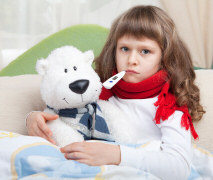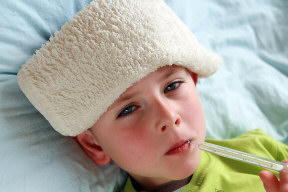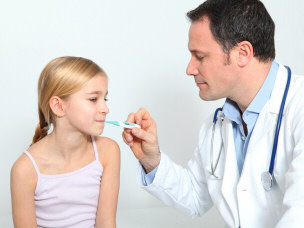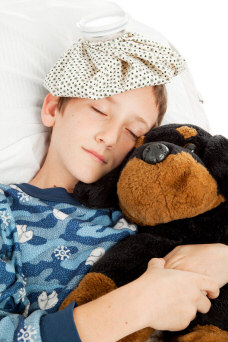Dealing With a Child Who Has a Fever
Introduction
 The first and the foremost thing I would like to tell parents is that fever is
not a disease, but a symptom of a disease. Whenever an infective agent enters
the body, it could be bacterial, viral or fungal; the body’s immune system
fights it. Fever is a manifestation of this battle. The first and the foremost thing I would like to tell parents is that fever is
not a disease, but a symptom of a disease. Whenever an infective agent enters
the body, it could be bacterial, viral or fungal; the body’s immune system
fights it. Fever is a manifestation of this battle.
High body temperature inhibits the growth of invading germs thus, too
vigorous an attempt to control the fever may actually prolong the duration of
the disease. On the flip side, if a child is prone to convulsions with the
sudden rise of fever, not starting or delaying temperature control measures may
result in the child getting convulsions. This would be unfortunate because each
episode of convulsions damages a few neurons (nerve cells) of the brain.
What Is The Normal Body Temperature?
The standard normal body temperature is 98.6°F or 37°C. A normal child can have
98°F in the morning and 99°F in the evening. A variation of two degrees or more
(98° to 100° or even 97° to 99°) is abnormal and should be investigated.
How to Record Temperature Correctly
 The mercury thermometer is still the most reliable means of recording
temperature. Digital thermometers also work satisfactorily. Strip thermometers,
which are to be placed on the forehead often give false readings and cannot be
relied upon. The mercury thermometer is still the most reliable means of recording
temperature. Digital thermometers also work satisfactorily. Strip thermometers,
which are to be placed on the forehead often give false readings and cannot be
relied upon.
Temperature can be recorded in the armpit (small children), in the mouth
(older children) and in the rectum (by a rectal thermometer). Temperature
recorded in the mouth is higher than the temperature recorded in the armpit, but
lower than the temperature recorded in rectum. For example, the child's armpit
temperature may be 100 degrees, oral temperature may be 101 degrees and rectal
temperature may be 102 degrees. Always tell your doctor where you have recorded
the temperature, whether in the armpit, mouth or rectum. Let your doctor do the
adding or subtracting if you have not recorded the temperature in the mouth. Do
not do it yourself.
A quick assessment of fever can be done by using the back of your hand. If
the child's skin feels:
- Cold - No fever
- Warm - Equivocal
- Hot – Fever
When Should You Take The Child To A Doctor?
-
 Any child less than two months old having fever should be taken to a
doctor as soon as possible. Any child less than two months old having fever should be taken to a
doctor as soon as possible.
Especially if he/she is not feeding well.
- If the child appears to be dull, listless and generally sick
- Difficulty in awakening the child
- Irritability, confusion or delirium
- Excessive crying
- Rapid breathing
- Repeated vomiting
- If the child has a stiff neck
- If there is a seizure (convulsion)
- Looking in one direction with fixed gaze
- The child has rashes
- Fever more than 102°F
Managing a Fever
-
 The child should wear minimum clothes, preferably cotton. The room
should be comfortably cool. It is advisable to put on the fan/AC depending
on the weather. The child should wear minimum clothes, preferably cotton. The room
should be comfortably cool. It is advisable to put on the fan/AC depending
on the weather.
- The fastest way to bring down the fever is cold sponging. Ice water
should not be used as it may cause shivering and rise in temperature. There
is no use of just keeping a wet cloth on the forehead. You must sponge the
entire body. Remember, the larger the area you cool, the faster the
temperature comes down. In case of a heat-stroke with hyperpyrexia
(temperature above 105°F), it may be necessary to bring down the fever
rapidly. In such cases, ice cold water is used or patients are packed in ice
bags at the hospital.
- Give Paracetamol (15mg/kg per dose) simultaneously, while starting the
cold sponge. Paracetamol takes an hour and a half to bring down the fever.
Thus, initially the fever is controlled by sponging and later the drug takes
over. You can repeat the dose of Paracetamol every four to six hours if the
fever recurs.
- After examining the child, your doctor may straightaway prescribe
antibiotics/antimalarials, etc. or he might decide to investigate the child
while controlling the fever with an antipyretic (fever reducer) like
Paracetamol, Ibuprofen, Mefencmic acid or Nimesulide.
- With fever most children tend not to eat, some don't even drink water.
If the child refuses solids, try to give semi-solids along with plenty of
fluids like fresh fruit juice, thin soups, freshly prepared lemonade, plain
water, and yes even colas. If the child doesn't accept regular food, give
chocolate bars, biscuits and cakes. The aim is to provide enough fluids and
calories.
Diseases & Conditions
Top Lists:
Top 10 Most Common Genetic Disorders
Top 15 Most Disturbing Skin Conditions
10 Unusual Phobias
Informational:
Diverticular Disease and Diverticulitis
What is Turner Syndrome and Why Does it Affect Only Females?
Alice in Wonderland Syndrome and How to Treat the Symptoms
Herniated Disc: Symptoms and Treatments
Pinch Nerve: The Cause of Remote Pain
Dealing With a Child Who Has a Fever
How Unhealthy Diet Could Trigger Inflammatory Arthritis
Phobias: Understanding How They Develop and Treatments
Depression Facts, Symptoms & Treatment
Earaches - Causes and Treatments
Symptoms of Borderline Personality Disorder and How to Deal with It
Seasonal Affective Disorder: Does Light Therapy Help?
What Really Causes Dandruff and How Can You Treat the Symptoms
Treating Plantar Fasciitis or Heel and Arch Pain
Symptoms and Treatments of Aplastic Anemia
Using Sclerotherapy to Get Rid of Varicose Veins
Are the Side Effects of HGH Supplements Worth It?
ADD/ADHD Symptoms and Treatment
What are the Options for Hair Loss Treatments
Options for Frontal Hair Loss Treatment |